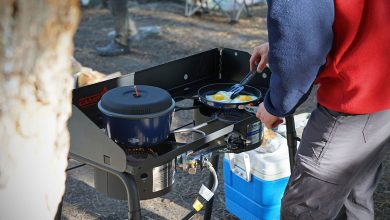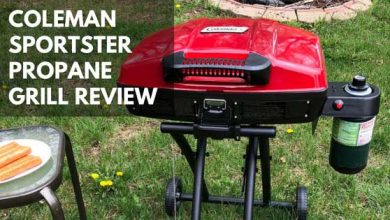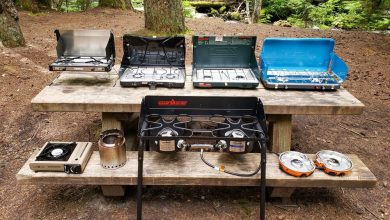15 Tips For Going Camping With Your Dog
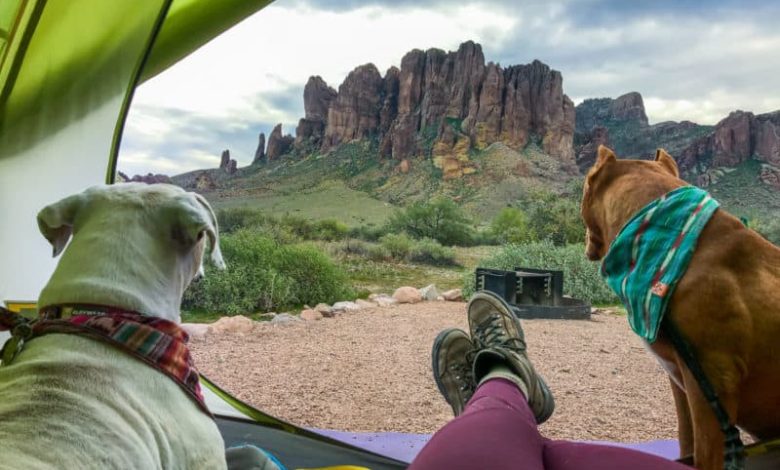
What are the best dog tips for camping? If it’s your first time camping with a dog then following these tips will help you out. Your first trip should be a fun experience that makes you want to bring your furry friends on future outings. This article will cover gear to bring, which campgrounds allow dogs, your food/water situation, and more. One of the most important steps is to prepare your dog physically, and mentally for the great outdoors. This step is often overlooked, but it’s important that your dog is prepared, comfortable being outside, and trained before leaving home.
Prepare your Dog
Preparing your dog gives you an idea of how they will act at the actual campground. If you instill good habits and prepare them physically, then camping will be a great experience. If you already know your dog well then this preparation should be much easier. You probably know that your dog loves chasing rabbits, is very active, or maybe your dog is used to being inside and sleeps a lot. Obviously, if your dog is a little bit lazy then you need to take more walks with him/her.
- Have a backyard campout: Also, get them used to being outside more, and reward them with treats for it. You can bring friends or their dog’s over to gauge their behavior around others.
- Gradually Increase car travel time: You probably have to drive in the car for a couple of hours or more to reach your campground. Preparing your dog for this ride by gradually increasing their car travel time. Additionally, plan to make plenty of stops for your pet to use the bathroom.
- Vocal commands: Teach them a reliable come and leave it a command. This training will keep them from wandering off because they will listen to your voice. They will leave hazardous plants or active squirrels alone as well if you use the leave it command.
- Practice leash commands: Train your dog not to lunge at others if this inconvenience bothers you, or if you own a particularly large canine.
Dog fitness
- Don’t bring a young puppy: A young dog’s bones should be fully developed before planning a trip. If you don’t know if your pup is ready then bring it to a vet for an expert opinion, especially if you are going to do long hikes.
- Physical preparation: Your dog might handle a short afternoon walk fine, but most of the day your dog sleeps on the couch with the a/c cooling. Suddenly making your dog endure intense physical activities is only a recipe for injury.
Research the area
What are the dangers?: Check the weather, the temperature, the animals, plants, and read reviews. Basic research will let you know if there are any animal predators nearby your campground or poisonous plants.
Documents, and how to get in.
Documents: In case something goes wrong some documentation will be helpful. Bring a picture in case your dog gets lost so you can show it to the rangers or fellow campers. Make sure the picture captures any distinguishing marks on your pet. Also, bring your vaccination record so you can be admitted into the park. Health records will be helpful for a nearby vet to see, so bring those as well.
- Bring your dog’s collar and ID information.
- Put a temporary ID tag on your canine with your campsite number.
Who allows Dogs: Generally anywhere cars are allowed pets are allowed. Developed campgrounds on public land, backcountry places, and dispersed campsites agencies that own the trails allow dogs. Although it’s best to check before you go, one way to check is by using BringFido.com to find pet-friendly campgrounds with ease.
No Dogs allowed: National parks don’t allow pets near backcountry areas, except in some roadside campgrounds, or backcountry areas.
Handy tools
Bring a mountain climbing lockable carabiner. This tool has many uses, for example, you can use it as a harness failsafe to prevent your dog from slipping free. Attach it around the metal loop of your dog’s collar, next attach the other end to your harness. If your harness has an issue the carabiner will stop the harness from slipping off. Use it to repair a broken leash, attach the carabiner to your backpack in case you want to snap a photo. These are just some of the uses. Why use a mountain climbing lockable carabiner? Carabiners can handle the heavyweight of a falling human, and some can lock which means your dog won’t break out accidentally at the right angle.
You can also use a stake or tether, and tie a leash around it if you want to keep your dog in a certain place at your campsite.
Food and water
Don’t suddenly switch your dog’s meal to some dog hiking food that your dog probably won’t eat. It’s best to keep them eating what they typically eat unless you feed them a custom diet. You won’t have a fridge or freezer, so get your dog used to a different food if you have them on a custom diet. If you have RV though, you could still freeze the meat in the RV fridge.
Bring plenty of water for your dog if you plan on doing plenty of hiking. How much water? Bring one ounce of water per pound of your dog’s body weight. Bigger dogs will need more water, as well as more food. If the day is hotter you will also need more water, that is why knowing the weather is important.
Your dog will also need more food the longer you decide to hike. As a general rule, feed your dog 25% more dog food than you normally feed them. There are also special types of dog food with more calories, protein, and less grain which are better suited for hiking. The food is a little lighter on the stomach and has more nutritious fuel to replenish your canine’s energy intake.
Backpack weight
If your dog has joint issues or other health problems then consult your vet before buying or using a backpack. Your canines backpack should be less than 25% for adult dogs. 10-15% is a good weight for puppies and senior dogs. Dog maturity depends on the breed so do your research for your particular dog if you want to determine the right pack weight.
On a related subject, make sure to properly adjust every strap to reach a good fit. Your dog needs to have room to breathe, but not to lose to escape the harness, somewhere in the middle will work best.
Check your dog’s paws and fur
- Nail trimming: Trim your dog’s nails so they don’t get stuck on anything along the trail.
- Grooming appointment: Cutting your dog’s hair is helpful to cool your dog down during warmer temperatures. Also, barbed seed pods can attach to fur or nails causing various problems to sensitive body regions like ears, eyes, and genitals. Cutting down your dog’s coat reduces this risk.
- Check their fur: Make a thorough inspection for ticks on your pet’s fur after your hike, because ticks can cause Lyme disease.
- Needle nose pliers extract thorns, quills, and “foxtails” which are very painful.
- Boots: Dog boots help prevent any thorns or foxtails from hurting your dog’s paws. Consider getting your dog used to wearing boots on your normal walk, then they can feel comfortable wearing them on a hike.
Dog gear
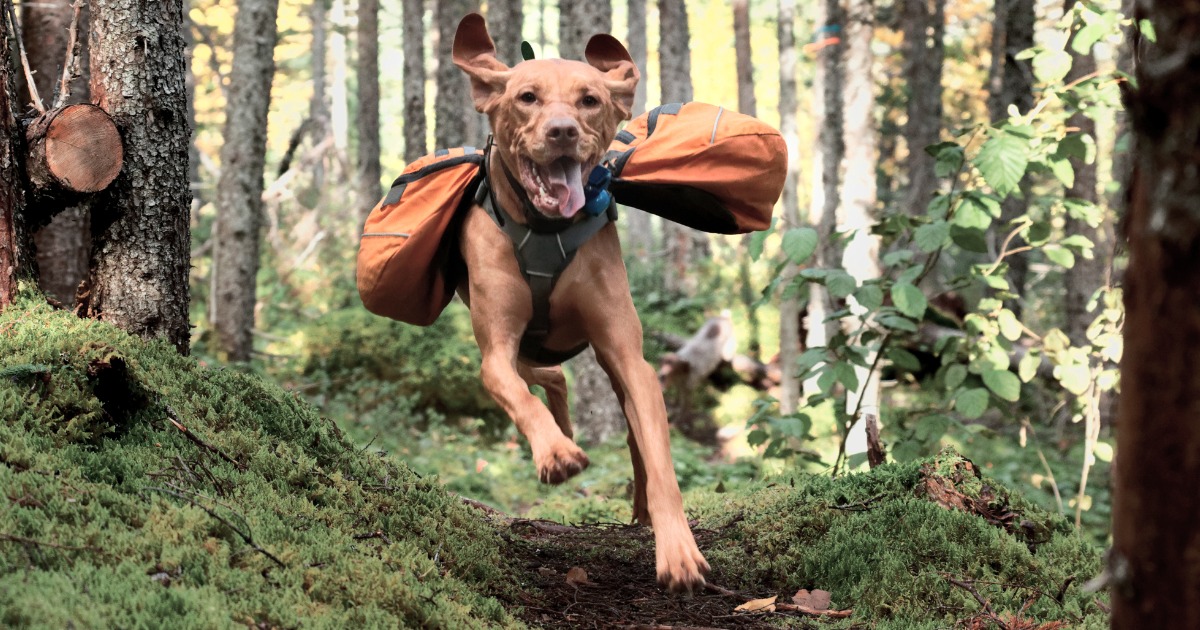
A shorter leash around six feet long is a good length for dogs who lunge at people whether it be to greet them or bark at people. If your dog is not obedient then don’t use a retractable leash, or if you do be ready to suddenly flip on the lock setting.
Your dog’s vest should be reflective or neon making it easy to notice him/her.
Harnesses are great for keeping your dog from lunging, and body harnesses are the safest option because they don’t pull on your dog’s neck. It can take a while for your dog to adjust to wearing a harness if they aren’t used to it, so remember to keep that in mind.
Snapware containers: These are light, foldable, and storable so definitely consider using one of these for a water dish.
Dog gear list:
- A filter
- A current photo
- Vet records and medical information
- An attachable ID tag
- Dog waste bags
Recommended item list:
- A dog brush
- An outdoor harness
- A swim-safe leash
- A bowl of water
- Dog treats
- Prescription medication/special medication if applicable
- Stake or tether
- Extra towels
- Dog first-aid kit
- Outdoor-safe toys
- A leash
- boots
- collar light
- A doggy daypack
- Your dog’s bed
- rain jacket
A bear bell: Clip it on your leash dog or backpack if you don’t mind the bell sound. The bell is meant to scare away wild critters.
Paw pads for winter conditions
Be courteous to others and nature
Remember to pick up your dog’s waste. It’s awful to step in and doesn’t biodegrade. Places are closed to dogs because people leave dog poop. Picking it up makes you a good dog ambassador, so set an example for responsible pet ownership. Conceal their poop in a hole about 6- to 8-inches, and make sure it’s at least 200 feet away from trails, camps, and water sources. Be ready to interrupt your dog if they begin to pee in or next to a water source. Also, make sure that your dog doesn’t howl or bark while everyone is trying to sleep, park rangers will receive complaints and it won’t be fun for anyone.
Health
Educate yourself on basic pet first aid skills. You can find great medical advice from the Red Cross pet first aid app. Learn some basic skills on that app or any knowledge about your dog’s specific health problems before you plan a hike.
Water and plant safety
Do not let your dog drink from stagnant water and be cautious of lakes, ponds, or rivers that could be contaminated by blue-green algae. Keep your dog clear from poison ivy, mistletoe, weird mushrooms, and other deadly local plants.
Heatstroke:
Dogs often may exhaust themselves if you don’t stop and rest. Take note if you see their tongue hanging from their mouth, a foamy mouth, or heavy panting.
What to do if your dog is overheating:
- Take an ice pack and wrap it around their groin area.
- Find a cool spot to rest during the hot day, monitoring their condition to see if they improve, most of the time they will.
- wet their chest and armpits
- give them a drink of water
- Find a dog bathing area to cool them down.
Heat Stroke symptoms:
- a temperature of 104 or higher means your dog is overheating.
- Panting
- Restlessness
- Weakness
- Agitation
- Dry gums
- Dry/bloody nose
- Disorientation
- Heavy breathing
- special bandages and tools designed for dogs.
- Bright red tongue
What to include in your first aid kit:
- antiseptic
- tweezers
- Tools
- Rimadyl for soreness
- Chlorhexidine wipes for wounds
- Pedialyte in case of diarrhea. (get dosing instructions from a vet.)
Important information to know before you go.
Know the name, phone number, and directions of a nearby veterinarian or pet emergency clinic
Vaccinations
On the subject of pet vaccinations, local parkers require your pet to have their rabies shot. This shot is the one they look for, and all of them require this shot. Also, leptospirosis or Lyme vaccines might be recommended in the area you are hiking. Make sure your pet is up to date on all of their vaccinations
Sharing the tent
A 4 person tent works much better than a 2 person tent because dogs can take up a whole lot of space. Also, using spacious tents will help keep you comfier and allows for more airflow, especially on rainy days.
Want to make your dog comfortable? Bring their favorite dog bed along, and if you want, set up a white sound system on your phone, or a fan to relax your dog before bed.
Does your dog sleeps in a crate, then bring a good tent size that will fit with a crate inside.
Never leave your dog unattended
Never leave the dog unattended in the car, at the campsite, at dog parks, or during activities.
Keep your dog close at night when you sleep, and after the sun is down. Leaving your dog on its own means predators could hurt or eat them, and people may steal them.
Toys and fun
What can you do with your dog around the campground to entertain them? Bring their favorite toy along. You could also bring a friend and their dog if they get along, or bring your second dog.
You can get your dog used to being outside by playing with them in the backyard. If you have a local park or backyard, bring them and play with them there. Then your dog may associate the outdoors with play and won’t mind being outside a lot during your camping trip.

